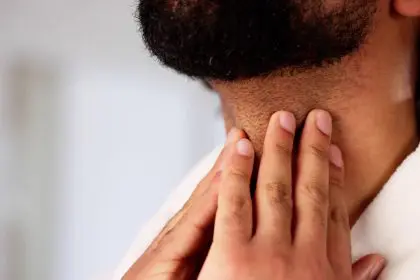Anxiety disorders have quietly become one of America’s most pervasive mental health challenges, affecting nearly one-third of adults during their lifetime. Far beyond typical stress or occasional worry, these conditions create persistent patterns that disrupt daily functioning and diminish quality of life.
Mental health professionals emphasize that recognizing early warning signs can be transformative for treatment outcomes. The sooner individuals identify these patterns, the more effectively they can address them through appropriate interventions.
Recognizing the physical manifestations
The body serves as an early warning system for anxiety disorders, often producing symptoms that seem unrelated to mental health. These physical indicators frequently appear before individuals recognize the psychological components of their condition.
Cardiovascular responses represent some of the most common early signs. Hearts race unexpectedly, even during calm moments, while blood pressure fluctuations create sensations of lightheadedness or dizziness. These episodes often occur without apparent triggers, leaving individuals confused about their origin.
Gastrointestinal disruption affects millions with anxiety disorders. Stomach pain, nausea, and digestive irregularities persist despite normal medical evaluations. The gut-brain connection means emotional distress directly impacts digestive function, creating a cycle where physical discomfort increases mental stress.
Muscular tension accumulates throughout the body, particularly in the shoulders, neck, and jaw. This chronic tightness leads to frequent headaches and overall fatigue as muscles remain perpetually contracted. Many individuals develop temporomandibular joint dysfunction from unconscious jaw clenching.
Mental and cognitive warning signs
Anxiety disorders fundamentally alter thought processes, creating patterns that feel impossible to control or interrupt. These cognitive changes often develop gradually, making them difficult to recognize initially.
Sleep disruption manifests in multiple ways. Some individuals struggle with racing thoughts that prevent initial sleep onset, while others experience frequent awakening throughout the night. Sleep quality deteriorates as the mind remains hypervigilant, scanning for potential threats even during rest periods.
Concentration difficulties emerge as attention becomes fragmented across multiple worries simultaneously. Simple tasks require excessive effort as the mind jumps between concerns. Work performance often suffers as focus becomes increasingly elusive.
Decision paralysis transforms routine choices into overwhelming challenges. Selecting clothing, food, or entertainment becomes exhausting as individuals analyze every possible negative outcome. This overthinking extends to more significant decisions, creating procrastination and avoidance behaviors.
Intrusive thoughts cycle repeatedly through the mind, often focusing on worst-case scenarios or unlikely catastrophes. These thoughts feel uncontrollable and create additional anxiety about having anxious thoughts, perpetuating the cycle.
Behavioral changes and social impact
Anxiety disorders inevitably influence behavior patterns and social interactions. These changes often represent coping mechanisms that initially provide relief but ultimately reinforce anxious patterns.
Social withdrawal begins subtly as individuals decline invitations or leave gatherings early. Previously enjoyed activities lose their appeal as social situations feel increasingly threatening or overwhelming. This isolation reduces opportunities for positive experiences and social support.
Panic episodes create intense fear accompanied by physical symptoms that can mimic serious medical conditions. Heart palpitations, shortness of breath, and chest pain during these episodes often lead to emergency room visits. The fear of experiencing another panic attack frequently triggers additional anxiety.
Energy depletion results from the constant state of heightened alertness that anxiety disorders maintain. Bodies remain in fight-or-flight mode, rapidly consuming energy reserves and leaving individuals feeling chronically exhausted despite adequate rest.
Understanding different anxiety presentations
Anxiety disorders encompass several distinct conditions, each with unique characteristics and triggers. Generalized anxiety disorder creates persistent worry across multiple life areas, while social anxiety disorder specifically targets interpersonal situations.
Panic disorder produces recurring panic attacks and fear of future episodes. Specific phobias focus intense fear on particular objects or situations, such as flying or enclosed spaces. Obsessive-compulsive disorder combines intrusive thoughts with repetitive behaviors designed to reduce anxiety.
Post-traumatic stress disorder develops following traumatic experiences, while agoraphobia creates fear of situations where escape might be difficult. Each condition requires tailored treatment approaches based on specific symptoms and triggers.
Modern treatment approaches
Contemporary anxiety treatment combines evidence-based therapies with pharmaceutical interventions when appropriate. Cognitive-behavioral therapy remains the gold standard, helping individuals identify and modify thought patterns that perpetuate anxiety.
Exposure therapy gradually introduces feared situations in controlled environments, reducing avoidance behaviors and building confidence. Mindfulness-based interventions teach individuals to observe anxious thoughts without judgment, reducing their emotional impact.
Medication options include selective serotonin reuptake inhibitors, which adjust neurotransmitter levels to reduce anxiety symptoms. Benzodiazepines provide short-term relief for acute symptoms but require careful monitoring due to dependency risks.
Lifestyle modifications for anxiety management
Daily habits significantly influence anxiety levels and treatment effectiveness. Regular physical activity naturally reduces stress hormones while increasing mood-stabilizing neurotransmitters. Aerobic exercise, yoga, and strength training all demonstrate anxiety-reducing benefits.
Nutritional choices affect mental health outcomes. Limiting caffeine and alcohol consumption reduces anxiety triggers, while increasing omega-3 fatty acids and complex carbohydrates supports stable mood regulation. Adequate hydration and regular meal timing prevent blood sugar fluctuations that can trigger anxiety symptoms.
Sleep hygiene practices create foundation for anxiety management. Consistent bedtimes, comfortable sleep environments, and pre-sleep relaxation routines improve sleep quality and reduce next-day anxiety levels. Electronic device limits before bedtime prevent blue light interference with natural sleep cycles.
The path toward anxiety recovery requires patience and professional guidance, but understanding these warning signs empowers individuals to seek appropriate help and begin their journey toward improved mental health.















